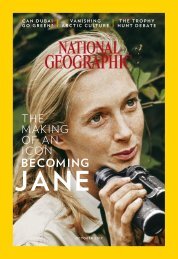NC
Create successful ePaper yourself
Turn your PDF publications into a flip-book with our unique Google optimized e-Paper software.
that off. And if it can happen here, they say, it<br />
can happen anywhere.<br />
SHEIKH MOHAMMED GREW UP in a house lit by<br />
oil lamps, where water from the village well was<br />
delivered by donkey cart. The house belonged to<br />
his grandfather, the emir; the Al Maktoum family<br />
has ruled Dubai since 1833. The house still stands<br />
near the mouth of Dubai Creek, a natural harbor<br />
that is the reason the city exists at all. Sheikh<br />
Mohammed’s father, Sheikh Rashid bin Saeed Al<br />
Maktoum, had grown up in the same house and as<br />
a young man had endured years when people in<br />
Dubai starved; the Great Depression and the invention<br />
of cultured pearls had destroyed the market<br />
for pearl diving, the town’s main enterprise.<br />
It was Sheikh Rashid who began to modernize<br />
Dubai after taking over as ruler in 1958 and especially<br />
after oil started to flow in the late 1960s. He<br />
quickly brought in electricity, running water, and<br />
paved roads. He built schools, an airport, and, in<br />
1979, the 39-story World Trade Centre (now Sheikh<br />
Rashid Tower), at the time the tallest building in<br />
the Middle East. “It was built in the middle of nowhere,<br />
on the edge of the city,” says Neil Walmsley,<br />
a Dubai-based British engineer and urban planner<br />
with the consulting firm Arup. “The city responded<br />
by growing towards it”—and then well past it.<br />
The pearl business hadn’t lasted forever, and<br />
Sheikh Rashid knew the oil wouldn’t either.<br />
Dubai holds just a fraction of the U.A.E.’s oil—<br />
Abu Dhabi has the lion’s share. So while Dubai<br />
was not a center of world trade in 1979, when<br />
Sheikh Rashid built the Trade Centre, he set<br />
about making it one. That same year he opened a<br />
second and larger port at Jebel Ali, 25 miles from<br />
the Creek, as it’s known.<br />
His son Mohammed filled the empty space between<br />
the two, turning Dubai into a hub not only<br />
of trade and finance but also, improbably, of tourism<br />
and real estate development. Each Emirati<br />
citizen has long been entitled to a plot for his own<br />
villa. But in the early 2000s, when Dubai began<br />
allowing property to be owned by foreigners—<br />
already attracted by the lack of income taxes—<br />
cash flooded in. Four large developers carved up<br />
the land. Workers streamed in from South Asia<br />
to build villas and skyscrapers clad in glass—not<br />
the ideal material in a land of relentless sun, but<br />
what the market demanded. The workers lived<br />
in camps that were often squalid, in conditions<br />
that some said resembled indentured servitude.<br />
The city exploded down the coast. It spread<br />
out into the Persian Gulf, onto artificial peninsulas<br />
built from titanic amounts of dredged sand; it<br />
spread into the Arabian desert. “When you look<br />
at how Dubai has been growing, it’s just been this<br />
obsession with building outward into the desert,”<br />
says Yasser Elsheshtawy, an Egyptian-American<br />
architect who taught at U.A.E. University in Al<br />
Ain for 20 years. “There were no limitations.<br />
Energy was cheap. You had cars. So why not?”<br />
Sheikh Mohammed’s aspiration is like his<br />
father’s, only grander: He wants Dubai to outcompete<br />
the world, to show the world that Arabs<br />
can be pioneers again, as they were in the Middle<br />
Ages. His strategy has been to attract the world<br />
to Dubai. Some 90 percent of the 2.8 million residents<br />
are expats living in a place where not so<br />
long ago a few thousand Arabs struggled to survive.<br />
Dubai’s population, young and incr edibly<br />
diverse—children attend schools with dozens of<br />
nationalities, several expats told me proudly—<br />
is its main resource. But all those people have to<br />
be kept alive in the desert.<br />
These days Dubai has plenty of electricity<br />
and running water. Almost all of it comes from<br />
a single two-mile-long industrial plant at Jebel<br />
Ali. There, in a line of candy-striped smokestacks<br />
and evaporator tanks, the Dubai Electricity and<br />
Water Authority (DEWA) burns natural gas to<br />
generate 10 gigawatts of electricity. The leftover<br />
heat is used to desalinate seawater—more than<br />
500 million gallons a day. Gas comes by pipeline<br />
from Qatar, with which the U.A.E. severed diplomatic<br />
relations in June, and in tankers from as<br />
far away as the United States.<br />
Dubai, a tiny emirate we think of as oil rich,<br />
depends on imported fossil fuel for life support.<br />
One DEWA official, trying to convey to me<br />
how that feels, gripped his throat tightly with<br />
one hand. But there’s an upside to that choking<br />
feeling: It can motivate you to change your<br />
circumstances.<br />
62 NATIONAL GEOGRAPHIC • OCTOBER 2017



